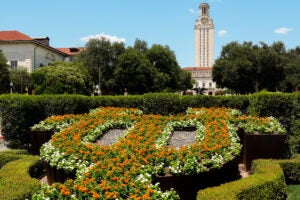If you’re walking along Guadalupe Street and look at the northwest corner of Goldsmith Hall, you might notice something different. The 10 x 25-foot honeycomb structure is a freshly planted living wall. The unique steel structure explores the role of architecture in ecology. It is built to hold interchangeable plastic soil containers with enough room to support the plant’s root system. This design is the result of a five year collaboration between The University of Texas at Austin’s School of Architecture and the Lady Bird Johnson Wildflower Center.
Installing a green wall in Austin represents a unique challenge. Similar projects are typically erected in more forgiving climates. A living wall in drought-prone Austin requires considerable thought and ingenuity.
To give the plants their best chance, Danelle Briscoe, an assistant professor in the School of Architecture, developed a honeycomb-shaped architectural structure, currently patent-pending. Its 148 “cells” (soil containers) were designed to accommodate a greater amount of dirt than is typically used — critical to sustaining the plants in Austin’s subtropical climate.
Michelle Bright, an environmental designer at the Lady Bird Johnson Wildflower Center, chose native plants from ecoregions around Austin for the wall pods (including wildflowers, succulents, shrubs, vines and grasses). These visually striking and heat-tolerant plants also serve as a wildlife habitat.
The carefully selected native plants were chosen to attract and provide shelter for anole lizards, hummingbirds, butterflies, and songbirds, among other beneficial fauna.

The wall will serve as a prototype for the project and its progress will be closely monitored. Researchers will monitor the design’s ability to cool the building and buffer noise. They will also gather and analyze data on how the plants filter out particulate matter, volatile organic compounds and carbon monoxide from the air. Its effectiveness could lead to more living walls on campus and perhaps throughout the city.
“The living wall will provide valuable data and insight into native flora, fauna, green design and sustainability,” said Fritz Steiner, dean of the School of Architecture. “We are grateful to The University of Texas at Austin for its support of this project and hope that our wall will be the first of many.”



